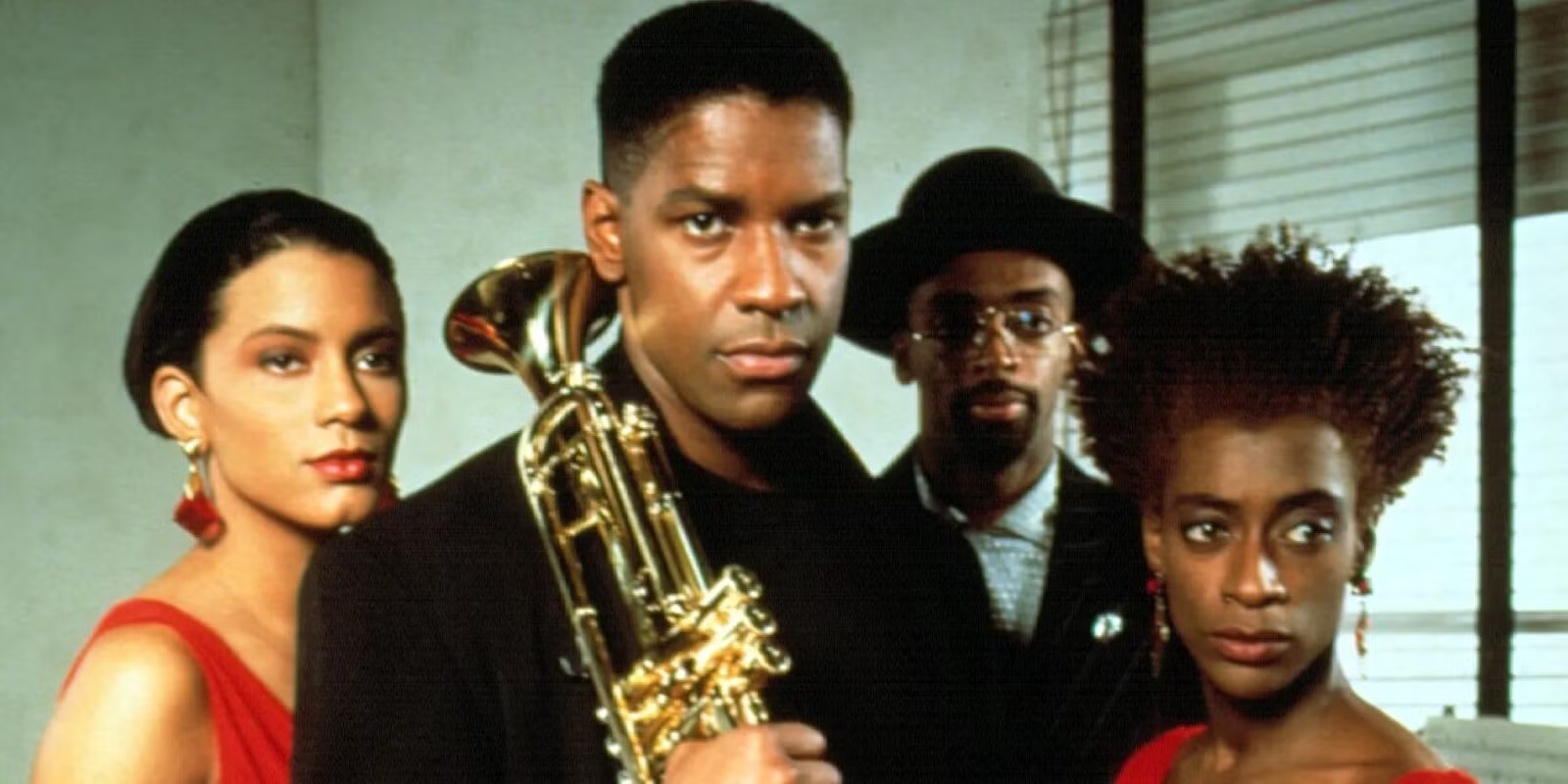Your cart is currently empty!
You Probably Missed Spike Lee and Denzel Washington’s First Movie Together
Overlooking their first collaboration would be easy, given their later masterpieces together. You might know them from Malcolm X or Inside Man, but their partnership began with 1990’s Mo’ Better Blues, where Washington portrays a talented but complex jazz trumpeter. The film showcases your favorite duo’s early chemistry, setting the foundation for what would become one of cinema’s most impactful partnerships. As Denzel Washington and Spike Lee spotted at the New York Knicks game recently reminds us, their creative relationship continues to thrive, with their fifth collaboration currently in development.
Key Takeaways:
- Mo’ Better Blues (1990) marked the first collaboration between Spike Lee and Denzel Washington, featuring Washington as a brilliant but troubled jazz musician
- The film was Lee’s follow-up to his breakthrough “Do the Right Thing” and took a more personal approach, exploring the struggles of artistry and ego
- The movie showcases authentic jazz culture through beautiful cinematography by Ernest Dickerson and costume design by Ruth Carter, while examining complex relationships between the protagonist and the women in his life

Background of Spike Lee and Denzel Washington
A dynamic partnership that would reshape American cinema began in the late 1980s when both artists were ascending to the heights of their careers. You might know them for their later collaborations, but their early works laid the foundation for what would become one of Hollywood’s most impactful director-actor relationships.
Spike Lee’s Rise to Fame
With his breakthrough film “She’s Gotta Have It” (1986), you could see Lee’s unique directorial vision emerging. His path to prominence accelerated with “Do the Right Thing” (1989), which earned him an Oscar nomination for Best Original Screenplay and established him as a bold voice in American filmmaking, addressing social issues with distinctive style.
Denzel Washington’s Early Career
Before becoming a household name, Washington built his reputation on stage and television. You might recognize him from his Emmy-winning role on “St. Elsewhere” (1982-1988), but his theatrical background, including a Tony Award for “Fences,” shaped his approach to character development.
Less known to many of you is Washington’s early stage work at the Negro Ensemble Company, where he honed his craft before breaking into film. His dedication to mastering his roles and powerful screen presence would make him the perfect collaborator for Lee’s visionary directing style.
Overview of Mo’ Better Blues
There’s a unique blend of jazz, romance, and personal struggle in Spike Lee’s 1990 film Mo’ Better Blues. You’ll find this character-driven drama showcasing Denzel Washington in his first collaboration with Lee, fresh off the success of Do the Right Thing. The film’s rich visual style, complemented by Ernest Dickerson’s cinematography and Ruth Carter’s costume design, creates an authentic yet heightened atmosphere that puts you right in the heart of New York’s vibrant jazz scene.
Plot Summary
Plot follows Bleek Gilliam (Washington), a talented but self-centered trumpet player leading a jazz quartet. You’ll witness his struggle to balance his musical career with personal relationships, while dealing with competition from his ambitious saxophonist Shadow Henderson (Wesley Snipes). Your journey through the film reveals a series of character-focused vignettes rather than a traditional narrative structure, showing how artistic pursuit can lead to personal isolation.

Main Characters
Along with Washington’s Bleek Gilliam, you’ll meet a compelling ensemble cast including Wesley Snipes as Shadow Henderson, Spike Lee as Giant (Bleek’s manager), Cynda Williams as Clarke, and Joie Lee as Indigo. Each character brings depth to the story of artistic ambition and personal relationships.
Main characters in the film reflect complex personalities you can relate to. Your attention will be drawn to Bleek’s relationships with his two love interests, Clarke and Indigo, who attempt to ground his artistic ego. The dynamic between Bleek and Shadow showcases the competitive nature of the jazz world, while Giant represents the business side of artistry.
Themes and Motifs
For your understanding of Mo’ Better Blues, you’ll find the film explores multiple interconnected themes that reflect both artistic ambition and personal relationships. Through Bleek Gilliam’s character, you’ll witness the struggle between professional excellence and personal fulfillment, while the jazz backdrop serves as a metaphor for life’s improvisational nature. You’ll notice how Lee weaves these elements together to create a tapestry of artistic expression and human connection.
Egoism in the Arts
Any analysis of Bleek’s character will show you how artistic ego can become destructive. You’ll recognize this theme through his obsessive practice routines and the way he dismisses others’ needs, including those of his bandmates. When Shadow Henderson challenges his leadership, you’ll see how Bleek’s pride prevents him from acknowledging others’ talents, reflecting the isolating nature of artistic pursuit.
Romantic Relationships and Personal Growth
To understand Bleek’s journey, you’ll need to follow his complicated relationships with Clarke and Indigo. Your attention will be drawn to how these relationships force him to confront his self-centered nature and eventually choose between his music and love.
In addition to the central conflict, you’ll notice how Lee portrays the women in Bleek’s life as catalysts for change. Through your observation of these relationships, you’ll see how Bleek’s mother’s early influence shapes his dedication to music, while his romantic entanglements with Clarke and Indigo present him with choices that challenge his artistic identity and force personal growth.
Cinematic Style
Once again, Lee demonstrates his masterful command of visual storytelling in Mo’ Better Blues, blending sophisticated camera movements with rich color palettes that mirror the jazz world’s vibrancy. You’ll notice his signature double-dolly shots and extreme close-ups that bring you intimately close to Washington’s performance, while the film’s artistic composition reflects both the elegance and chaos of Bleek’s musical journey.
Visual Presentation
Across the film, you’ll find yourself immersed in Ernest Dickerson’s stunning cinematography that captures the smoky atmosphere of New York’s jazz clubs with remarkable authenticity. Your eyes will be drawn to the way light plays across the brass instruments, and how the camera glides through performances, making you feel as if you’re right there on stage with the musicians.
Music and Jazz Influence
Above all else, you’ll experience how the film’s musical elements become a character of their own. Bill Lee’s original score, combined with classical jazz pieces, creates a soundscape that guides you through Bleek’s emotional journey, while the performance sequences showcase your front-row view of Washington’s convincing portrayal of a trumpet virtuoso.
Indeed, your appreciation for the film’s musical depth grows as you recognize how each composition mirrors Bleek’s internal struggles. The soundtrack, featuring both original pieces and jazz standards, helps you understand the character’s artistic passion while highlighting the personal cost of his dedication. You’ll notice how the tempo and intensity of the music shift to match the emotional beats of Washington’s performance, creating a seamless blend of sound and story.
Critical Reception
Keep in mind that when Mo’ Better Blues hit theaters in 1990, you would have witnessed mixed reactions from critics and audiences alike. While some praised Lee’s stylistic direction and Washington’s magnetic performance, others found the narrative structure challenging to follow. The film’s box office performance was modest, earning approximately $16 million against its $10 million budget.
Initial Reviews
The contemporary critics focused heavily on your experience of Washington’s portrayal of Bleek Gilliam, with many highlighting his ability to make an unlikeable character compelling. However, some reviewers took issue with what they perceived as stereotypical portrayals of certain characters, particularly in the film’s representation of Jewish club owners.
Legacy of the Film
Beside its initial reception, you’ll find that Mo’ Better Blues has gained appreciation over time for its stunning visual style and complex character study. The film has become recognized as an important early collaboration between Lee and Washington, setting the foundation for their future masterworks.
In fact, if you look at modern film analysis, you’ll notice how the movie’s themes of artistic dedication versus personal relationships have influenced contemporary filmmakers. The jazz sequences and Ernest Dickerson’s cinematography continue to be referenced in film schools, and the movie’s exploration of an artist’s ego has become more relevant in today’s celebrity-driven culture.

Lee and Washington’s Collaborations
Not many actor-director pairs have achieved the artistic synergy that you’ll find in Spike Lee and Denzel Washington’s work together. Their partnership, spanning four films over three decades, has consistently delivered powerful performances and compelling storytelling. From their first collaboration in ‘Mo’ Better Blues’ (1990) to their upcoming project ‘Highest 2 Lowest’ (2025), you’ve witnessed their shared commitment to creating meaningful cinema.
Subsequent Films Together
Along with ‘Mo’ Better Blues’, your journey through their collaborations includes the powerful biopic ‘Malcolm X’ (1992), the father-son drama ‘He Got Game’ (1998), and the thrilling heist film ‘Inside Man’ (2006). Each project showcases your chance to see Washington’s versatility as an actor under Lee’s distinctive directorial vision.
Impact on Black Cinema
Below the surface of their collaborations, you’ll find a transformative influence on Black cinema. Their partnership has elevated storytelling beyond conventional narratives, offering you authentic portrayals of Black experiences while challenging Hollywood’s traditional representations.
But what you might not realize is how their work together has reshaped the landscape of American cinema. Their films have consistently broken box office records while maintaining artistic integrity, proving to you that commercially successful films can also carry significant social commentary. Through their partnership, you’ve seen the emergence of complex Black characters and narratives that continue to influence filmmakers today.
Final Words
Ultimately, your understanding of the Lee-Washington collaboration isn’t complete without exploring their first partnership in ‘Mo’ Better Blues’. You’ll find this 1990 film showcases the early seeds of their creative synergy, offering a unique glimpse into Lee’s personal reflections on artistry and fame through Washington’s portrayal of Bleek Gilliam. If you’re seeking to trace the evolution of their artistic relationship, this film serves as the important starting point that laid the foundation for their future masterpieces. Movie TV Tech Geeks MovieFeatures #SpikeLee #DenzelWashington Deep Dive
FAQ
Q: What was unique about Mo’ Better Blues in Spike Lee’s filmography?
A: Mo’ Better Blues stands out as one of Lee’s most personal films, being a looser and quieter character drama compared to his previous work. It was his first collaboration with Denzel Washington and reflected Lee’s own experiences with fame and artistry through the story of a jazz musician. The film focuses more on character dynamics than plot, exploring themes of artistic pursuit and personal relationships.
Q: How did Denzel Washington’s character differ from his later roles with Spike Lee?
A: In Mo’ Better Blues, Washington played Bleek Gilliam, a narcissistic trumpet player – a departure from his later, more politically charged roles in films like Malcolm X. This character was more introspective, focusing on personal struggles with relationships and artistic excellence rather than broader social issues. The role showcased Washington’s ability to portray complex, flawed characters early in his collaboration with Lee.
Q: What artistic elements made Mo’ Better Blues distinctive?
A: The film featured stunning visual elements, including beautiful photography of nightclubs and stages by cinematographer Ernest Dickerson. Ruth Carter’s costume design created an authentic yet stylized atmosphere. The jazz backdrop was treated with genuine affection, and the film balanced both humorous and melancholic moments while exploring the theme of artistic self-destruction.
Featured Articles
Search
Author Details

Michael Kaswatuka – The Stone Builders Rejected
At The Stone Builders Rejected, we offer a wide range of services to clients of all industries. From SEO to social media marketing, our team has a wide range of experience in all facets of digital marketing, advertising, PPC, and content marketing. we have the experience and expertise to help your business grow.















Leave a Reply